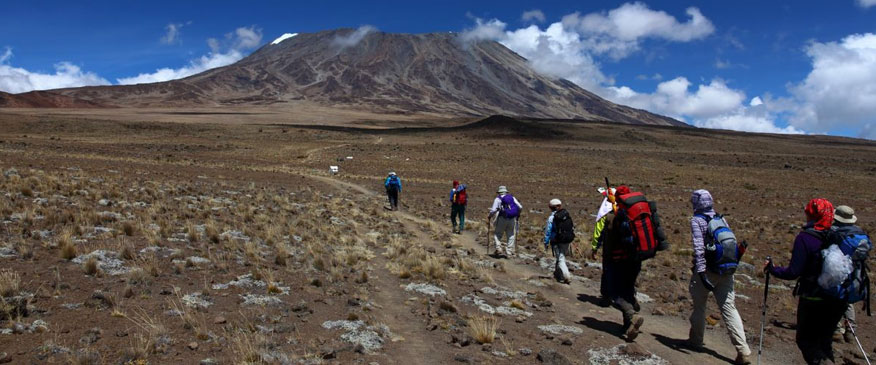
Tour Overview
Known as the “Whiskey” route, the Machame route is now the most popular route on the mountain. Compared with Marangu, the days on Machame are longer and the walks are steeper. The Machame route is considered a difficult route, and is better suited for more adventurous folks and those with some hiking or backpacking experience.
The route begins from the south, then heads east, traversing underneath Kilimanjaro’s southern ice field before summiting. The minimum number of days required for this route is six days, although seven days is recommended.
Day by Day Itinerary
Day 1: Machame Gate (1,800m/5,900ft) to Machame Camp (3,000m/9,800ft)
Elevation Gain: 1,200 metres / 3,900 feet
Your head guide will meet you for the drive from Moshi to the Machame Gate (approximately 45min). After registration, begin climbing along a winding trail through beautiful and lush forest. Since this is the zone which experiences the most rainfall on the mountain you should be prepared for afternoon showers. These can make the trail slippery at times! The climb is steady, gradually easing as you approach camp at Machame Hut (9,800ft). The camp is located on the edge of the forest and giant heather zones. Approximately 6-7 hours of walking today.
Day 2: Machame Camp (3,000m/9,800ft) to Shira Camp (3,840m/12,600ft)
Elevation Gain: 840 metres / 2,800 feet
Today is a little shorter, beginning by climbing a steep ridge to reach a small semicircular cliff known as Picnic Rock. There are excellent views of Kibo, the summit cone of Kilimanjaro, and the jagged rim of the Shira Plateau. Shira is the third of Kilimanjaro’s volcanic cones. It is filled with the lava flow from Kibo and its rim has eroded and been blasted away by weather and volcanic action. Once on the plateau the trail becomes gentler as you continue your climb to Shira Camp. On a clear day the views from here are spectacular. Approximately 5-6 hours of walking.
Day 3: Shira Camp (3,840m/12,600ft) to Barranco Camp (3,850m/12,650ft) via Lava Tower (4,550m/14,900ft)
Elevation Gain: 710 metres / 2,300 feet
Elevation Loss: 700 metres / 2,250 feet
Your climb today will take you steadily up and over the expansive ridgelines of high desert to Lava Tower. The trek to the base of Lava Tower is about 4 hours. This tower is a 300 foot high volcanic plug. If time and energy allow, you can scramble to the top of Lava Tower for fabulous panoramic views. From Lava Tower we begin our steep descent into the Barranco Valley, passing large flowering plants which actually look like trees, the scenecios. This is good practice for your descent from the summit in a few days time and will take 1-2 hours. Although you will end your day at almost the same elevation as you started, today is very important for acclimatisation and will help your body prepare for summit day. Barranco Camp is in a beautiful, sheltered valley below the imposing Barranco Wall.
Day 4: Barranco Camp (3,850m/12,600ft) to Karranga Camp (3,950m/13,000ft) via the Barranco Wall (4,200m/13,800ft)
Elevation Gain: 350 metres / 1,150 feet
Elevation Loss: 250 metres / 820 feet
After breakfast, we leave Barranco Camp and begin our climb up the Barranco Wall. This is an impressive scramble where you will be rewarded with fantastic views back towards camp. The porters climbing the wall are also an impressive sight. From the top, at 4,200m, you will follow an undulating path around the mountain side. On a clear day there are spectacular views of Kibo to your left and Mount Meru to your right. After descending into the Karranga Valley your climb takes you up a short steep path to Karranga Camp. Walking time approximately 3-4 hours.
Day 5: Karranga Camp (3,950m/13,000ft) to Barafu Camp (4,600m/15,100ft)
Elevation Gain: 650 metres / 2,150 feet
Today you will spend the morning climbing steadily on to Barafu, which is Swahili for ice! This camp is located on the ridge below the summit cone. You have now completed the South Circuit, which offers views of the summit from many different angles. This walk will take around 3 hours meaning that you will arrive at Barafu in time to spend the afternoon resting and enjoy an early dinner in preparation for the summit climb. The two peaks of Mawenzi and Kibo can be seen from this position.
Day 6: Barafu Camp (4,600m/15,100ft) to Uhuru Peak (5,895m/19,300ft) then descending to Mweka Camp (3,110m/10,200ft)
Elevation Gain: 1,295 metres / 4,200 feet
Elevation Loss: 2,785 metres / 9,100 feet
In the early hours of the morning you will begin your final ascent to the summit of Uhuru Peak. This part of the climb takes approximately 6-8 hours. It can be very cold at night at these elevations, but it will be quite warm by the end of the hiking day and therefore you will want clothing for both extremes. Just when you think you’ve had enough of climbing in the dark the sun will rise and you will be rewarded with a rich red sky framing Mawenzi. At Stella Point (5,750m) you join the crater rim. From here, climb gently to Uhuru Peak which is the highest point on Mount Kilimanjaro and the continent of Africa. From the summit the descent will take you straight down to Mweka Hut, with lunch served on the way. This part of the descent takes about 6 hours. Later in the evening enjoy your last dinner on the mountain and a well-earned sleep.
Day 7: Mweka Camp (3,110m/10,200ft) to Mweka Gate (1,830m/6,000ft)
Elevation Loss: 1,280 metres / 4,220 feet
Descend straight to the gate through lush forest (2-3 hours), looking for monkeys along the way. Return to Moshi from Mweka Village.
Prices Include:
Park fees, camping fees, rescue fees, head guide, assistant guides, cook, & porters salaries, all food, drinking water, tents, transport to/from park entry gate.

